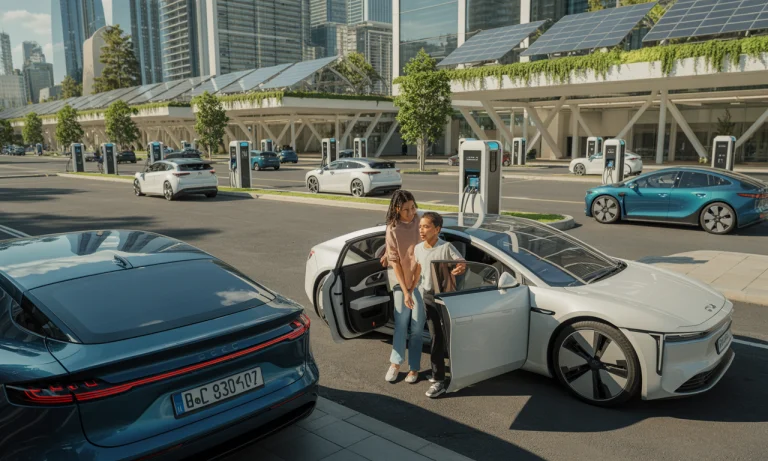As sunrise floods downtown Austin, a quiet hum replaces the morning roar. More drivers than ever are sliding into the seats of pre-owned electric cars, their dashboards blinking to life with promise. Once led by Tesla, today’s secondhand EV marketplace teems with options from Nissan, Chevrolet, Hyundai, BMW, Ford, Kia, Volkswagen, Audi, and newcomer Rivian. This transformation hasn’t happened overnight. Alongside expanding government incentives and a surge of off-lease returns, a nation-wide evolution is reshaping what it means to buy used. Still, for those weighing an eco-friendly ride on a budget, persistent questions linger: Is a used electric vehicle genuinely reliable? Will the battery last, or will costs balloon unexpectedly? And where do the hidden gems in this still-growing landscape lie? Let’s meet Tom, whose hunt for a cost-effective, planet-friendly commute leads him into the world of used EVs, and discover if the reality in 2025 matches the buzz.
Shifting Tides: The Surging Used Electric Car Market Explored
One glimpse at the used electric vehicle scene and it’s clear: things have never moved faster. Gone are the days when buyers were confined to a lone Tesla model. Walk into any reputable dealership and you’ll find fleets of pre-owned options—sleek BMW i3s awaiting urban adventures, sturdy Ford Mustang Mach-Es, Kias that combine utility with affordability, and reliable Nissan Leafs for budget-conscious drivers. The influences are layered: rapid advances in EV tech push early adopters to upgrade, while an influx of low-mileage trade-ins and off-lease models bolster inventory. California remains ground zero for adoption. Yet, as Recurrent’s industry report reveals, Texas and Florida now close the gap, each state boasting a fresh generation of EV converts. This democratization changes who buys, why they buy, and what’s possible. For Tom, shifting from gas to electric no longer means compromise—it’s a tailored journey.
| Brand | Popular Used Model | Approximate Price Range | Estimated Range (miles) |
|---|---|---|---|
| Tesla | Model 3 | $28,000–$32,000 | 220–300 |
| Nissan | Leaf | $14,000–$20,000 | 90–150 |
| Chevrolet | Bolt EV | $18,000–$27,000 | 238–259 |
| Hyundai | Kona Electric | $22,000–$29,000 | 258 |
| Kia | Niro EV | $20,000–$29,000 | 239–282 |
| Ford | Mustang Mach-E | $27,000–$37,000 | 211–300 |
| Volkswagen | ID.4 | $24,000–$33,000 | 250–275 |
| BMW | i3 | $15,000–$23,000 | 120–153 |
| Audi | e-tron | $32,000–$40,000 | 222 |
| Rivian | R1T (emerging) | $45,000–$59,000 | 260–314 |
Chasing Value: Why Secondhand Electric Cars Are Tempting
Tom’s decision isn’t just about curb appeal; it’s about smart, sustainable economics. Used electric vehicles have, by nature, shed most of their initial depreciation—sometimes up to 40% in three years. Buyers today can nab a Tesla Model 3 or Nissan Leaf well below initial sticker, with federal and state credits stacking the savings even further. According to recent research, 57% of the used EV market sits under $30,000. That puts premium features—leather upholstery, top-shelf sound, Tesla’s Autopilot, even panoramic sunroofs—within reach of buyers who once settled for basic. Suddenly, joining the electric revolution isn’t just for early tech adopters or the well-heeled. It’s for families, commuters, and urban parents balancing soccer drop-offs with an eye on their monthly budget. In conversations with other buyers on EV forums, Tom finds stories that mirror his: big comfort gains and a lighter carbon footprint, without the bleeding-edge price tag.
What Every Buyer Needs to Know About Used Electric Car Reliability
There’s excitement in discovery, but Tom knows caution is essential. The heart of every electric car is its battery—still the single most expensive component if things go wrong. While stories about battery degradation circulate, the reality in 2025 is nuanced. Data shows fewer than 1% of model years 2016 and newer have seen battery replacement. On average, batteries retain 70–80% health after 100,000 miles, and many are outlasting industry expectations. Brands like BMW and Hyundai have earned strong reputations for battery longevity, while early Nissan Leafs (2011–2015) and some Volkswagen models earn scrutiny for faster wear. Vigilant buyers check health reports, evaluate warranty coverage, and factor in potential replacement costs, which can range from $7,000 to $15,000. Tom’s peace of mind increases with each certified pre-owned inspection—including a detailed look at the battery’s life and charging history, aided by tools recommended in guides like this one.
| Model Year | % Battery Replacement Seen | Typical Battery Health After 100,000 Miles |
|---|---|---|
| 2016–2023 (most brands) | Under 1% | 70–80% |
| 2011–2015 (Nissan Leaf, select VW) | 5–8% | 55–65% |
Overcoming Common Concerns: Range, Charging, and Warranties
Range anxiety once dominated EV headlines, but today, Tom finds his city dotted with new fast chargers. National networks have filled urban gaps, while highways now feature rapid stations every 50–70 miles. While a used Kia or Ford still offers less punch than a brand-new flagship, models like the Chevrolet Bolt and Hyundai Kona Electric regularly break the 250-mile barrier. For rural or long-haul drivers, though, careful planning remains key. In situations where older EVs sport shorter ranges, many buyers leverage apps and maps to locate chargers or plot commutes. Warranty coverage is a another pillar: Tom learns that certified dealers often include extended protection, while direct-from-owner deals require sharper scrutiny of any remaining manufacturer coverage. Stories from Reddit’s EV forums and real-world anecdotes help new buyers distinguish red flags from minor quirks.
Insider Moves: Getting the Best Deal on a Used Electric Vehicle
Deals in 2025 aren’t just about lucky timing—they reward those who prepare. Tom sets calendar reminders for end-of-quarter showdowns and studies market cycles, discovering advice tucked away in articles like car-buying mistake guides. When sale season hits and lease returns glut the market, dealerships get aggressive. Taxes and incentives sweeten the pot further: if Tom picks a qualifying EV under $25,000, he’s in line for a $4,000 federal credit—plus state or utility rebates. Negotiation hinges on real data: battery state, included chargers, accident history, and available accessories. Knowing when to walk away, or where secret local incentives lurk, sometimes saves thousands. Tom connects with buyers who scored lower prices during late fall slowdowns, and embarks on test drives armed with questions and a spirit of curiosity, following playbooks from automotive experts on timing purchases.
| Timing for Best Deals | Typical Offerings |
|---|---|
| End of Fiscal Quarters | Dealership discounts, trade-in incentives |
| Tax Season | High inventory, fleet vehicle sales |
| Late Fall/Winter | Slowed demand, lower prices |
Armed with knowledge, Tom’s experience becomes a case study for others: thorough research, patience, and the willingness to ask questions elevate a used EV search from gamble to savvy negotiation. Every transaction is a reminder—hidden opportunities reward those who dig deeper.
The Bigger Picture: Used EVs and Tomorrow’s Mobility
The pre-owned electric market has matured into its own ecosystem. Readers who crave further vision on where autonomous vehicles and electrification might lead can explore deeper dives at LeftLaneNews or dig into the cost structure of owning an EV at this detailed cost breakdown. As technology improves and the pace of lease returns accelerates, today’s used EV owner stands poised at the crossroads of sustainability, advanced tech, and unprecedented value. Tom, like so many others, finds his decision was less about compromise and more about seizing the future, one silent mile at a time.
Answers to Common Used EV Buyer Questions in 2025
Can you trust the reliability of used electric cars compared to new models?
Absolutely—especially with models from Tesla, Hyundai, BMW, and other top brands. The majority from 2016 onwards show minimal battery replacements. Always verify remaining battery health before purchase, preferably using a third-party inspection.
How long can I expect the battery to last in a used EV?
Most modern EV batteries perform well for 8–15 years, retaining 70–80% range after 100,000 miles. While there are exceptions (notably some older Nissan Leafs), robust advancement in battery chemistry has improved longevity. For more on battery lifespan, read this in-depth guide.
Are tax incentives still available for used EVs in 2025?
Yes, federal credits of up to $4,000 apply for many secondhand electric vehicles, with qualification based on price and buyer income. A variety of state and utility programs add further rebates, making deals even sweeter.
Which used electric models offer the best value under $30,000?
Top recommendations include the Tesla Model 3, Chevy Bolt EV, Hyundai Kona Electric, Nissan Leaf, and Volkswagen ID.4—offering a blend of reliability, range, affordability, and features. For families, explore more options here: best electric family cars.
Should I buy from a certified dealership or a private party?
Certified dealers provide more peace of mind—extended warranties, vehicle inspections, and streamlined financing. However, knowledgeable buyers may negotiate better prices with private sellers who have full maintenance records and transparent battery reports.
Curious how electric fits into your lifestyle? Explore expert car-buying tips, resale strategies, and repair savings at LeftLaneNews—and join the silent revolution, one drive at a time.
Did you like it? 4.6/5 (25)







